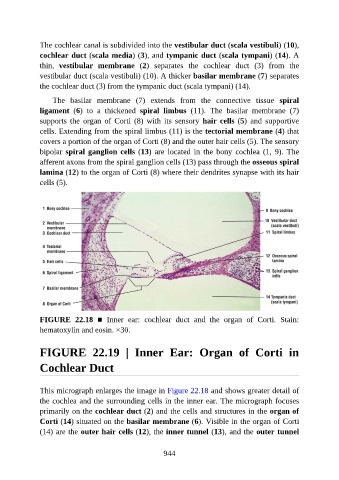Page 945 - Atlas of Histology with Functional Correlations
P. 945
The cochlear canal is subdivided into the vestibular duct (scala vestibuli) (10),
cochlear duct (scala media) (3), and tympanic duct (scala tympani) (14). A
thin, vestibular membrane (2) separates the cochlear duct (3) from the
vestibular duct (scala vestibuli) (10). A thicker basilar membrane (7) separates
the cochlear duct (3) from the tympanic duct (scala tympani) (14).
The basilar membrane (7) extends from the connective tissue spiral
ligament (6) to a thickened spiral limbus (11). The basilar membrane (7)
supports the organ of Corti (8) with its sensory hair cells (5) and supportive
cells. Extending from the spiral limbus (11) is the tectorial membrane (4) that
covers a portion of the organ of Corti (8) and the outer hair cells (5). The sensory
bipolar spiral ganglion cells (13) are located in the bony cochlea (1, 9). The
afferent axons from the spiral ganglion cells (13) pass through the osseous spiral
lamina (12) to the organ of Corti (8) where their dendrites synapse with its hair
cells (5).
FIGURE 22.18 ■ Inner ear: cochlear duct and the organ of Corti. Stain:
hematoxylin and eosin. ×30.
FIGURE 22.19 | Inner Ear: Organ of Corti in
Cochlear Duct
This micrograph enlarges the image in Figure 22.18 and shows greater detail of
the cochlea and the surrounding cells in the inner ear. The micrograph focuses
primarily on the cochlear duct (2) and the cells and structures in the organ of
Corti (14) situated on the basilar membrane (6). Visible in the organ of Corti
(14) are the outer hair cells (12), the inner tunnel (13), and the outer tunnel
944

